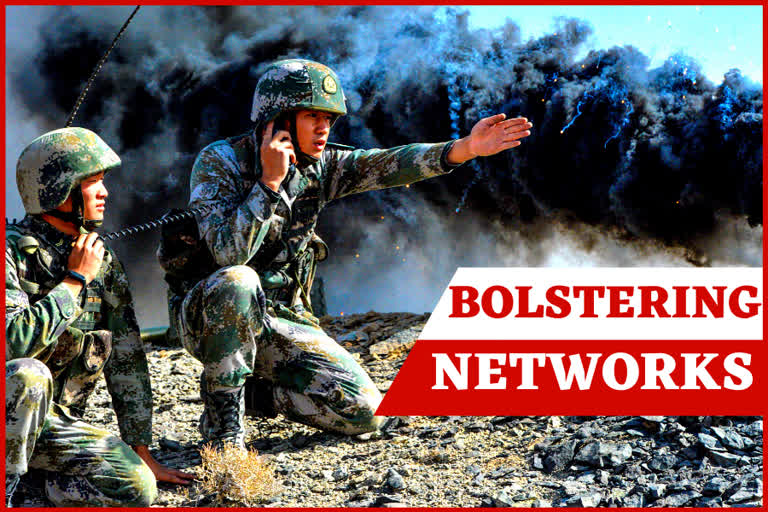Hong Kong: In the wake of border clashes along the Indo-China border, but harking back well before that, the People's Liberation Army's (PLA) has been bolsteringits defensive networks along the undemarcated Line of Actual Control (LAC).
In fact, given the current tensions and massed troops on both sides, there is a danger that the LAC will become more like the Line of Control with Pakistan, a heavily fortified and strongly defended border where weapon fire exchanges regularly occur.
A report by Sim Tack's research asserted: "China's construction drive projects a future military capability that will see long-term regional tensions with India sustained beyond the two countries' recent standoffs. The 2017 Doklam crisis appears to have shifted China's strategic objectives, with China more than doubling its total number of airbases, air defense positions and heliports near the Indian border over the past three years. The rapid expansion of permanent Chinese military infrastructure points to intentions that span a wider timeframe than current and recent border standoffs."
Read also:PLA's history shows trails of deception
The Stratfor article continued, "China's strategy aims to confront India with an insurmountable challenge in territorial disputes by leaning on broad support capabilities that provide Beijing with a tremendous ability to mobilize forces into disputed border areas. Such an approach is similar to China's strategy in the South China Sea, where a build-up of permanent defense facilities supports Chinese localized military superiority and significantly raises the potential cost of military opposition to Beijing's maritime claims in the region. In applying this same strategy on the Indian border, China aims to discourage Indian resistance or military action during future border disputes by ostentatiously demonstrating its ability and intent to engage in military confrontations."
One important difference along the LAC compared to the South China Sea, however, is that the former is solely a military confrontation. In the latter, China can use its coast guard or maritime militia in "gray-zone" contingencies to assert its claims. With no other players existing in isolated sections of the LAC, activity is confined purely to military operators.
Chinese airpower also allows the PLA to project military strength deep into the Himalayas. New infrastructure development supports this - for example, new aircraft shelters are being built that make it harder to observe planes. The PLA Air Force (PLAAF) has been operating H-6 bombers from Kashgar Air Base, these loaded with KD-63 land-attack cruise missiles. Similar bombers have also appeared at Golmud in Qinghai Province, along with Y-20 transporters, while the presence of 18 helicopters there suggests they could be rehearsing special forces heliborne operations.
Read also:PLA troops fired in air to intimidate: Indian Army
Tack concluded, "By forcing India to respond in kind, China's aggressive strategy is leading to a greater concentration of military assets in heavily disputed areas along the border that could raise the risk of potential escalations and sustained conflict." Correspondingly, India announced on 14 September that it would build six new runways and 22 helipads across Ladakh.
"Efforts by both India and China to translate these capabilities into dominance during future border disputes will increase the possibility of direct confrontations. And with strong logistical structures supporting frontline forces on both sides, such incidents could rapidly devolve into greater military engagements between the two nuclear-armed neighbours," Tack bleakly forecast.
As mentioned, the PLAAF has stiffened its SAM defenses, with several new HQ-9 sites under construction along the LAC. An existing deployment is at Gonggar, but new sites have appeared at Manasarovar (opposite Uttarakhand), Shigatse, Pagri (bordering Bhutan and Sikkim) and Nyingchi. This suggests the PLAAF has weakened its air defenses elsewhere to bolster strength in Tibet.
Both sides accuse each other of firing shots along the LAC, the first time this has occurred in 45 years. Despite ministerial-level talks agreeing to disengage, both sides continue to mass troops along the border. The threat of further confrontation is definitely real.
Oriana Skylar Mastro, a Center Fellow at the Freeman Spogli Institute for International Studies at Stanford University, discussed for the Lowy Institute in Australia how an armed Sino-Indian conflict could be resolved if it did occur. "Unless India is squarely defeated and thus cannot continue to fight, or China decides to withdraw unilaterally again, the war may drag on for longer than either side wants."
She said power asymmetries matter, since it is less risky for two evenly matched opponents to talk whilst still fighting since neither can be classified as the loser. "While India does enjoy some local advantages, Chinese conventional military power is superior to that of India. If China enjoys undisputable operational success, Beijing will likely offer talks quickly to the Indian side. China would do so to lock in any territorial gains with a peace agreement if India agrees, and looks reasonable in the international community's eyes if New Delhi refuses."
Mastro continued, "India's calculations will likely be the opposite. Rhetoric on how China believes India to be weak, and the need to stand up to Chinese aggression, will surge. Any Indian politician that suggests talking with the Chinese will be attacked. In other words, unless India is squarely defeated and thus cannot continue to fight, or China decides to withdraw unilaterally again, the war may drag on for longer than either side wants."
There are complicating factors, however, such as any US support for India. Russia is friendly to both India and China, and it could emerge as a mediator.
Mastro concluded, "Complex calculations about how the enemy will interpret and respond to a willingness to talk create an extra obstacle to peace when wars break out. This means high costs even if the war stays at the conventional level, because it is likely to drag on. The other possibility is that the war ends quickly because China secures a decisive victory. But this scenario does not bode well for the future either. It would leave the world with a weaker India and emboldened China."
